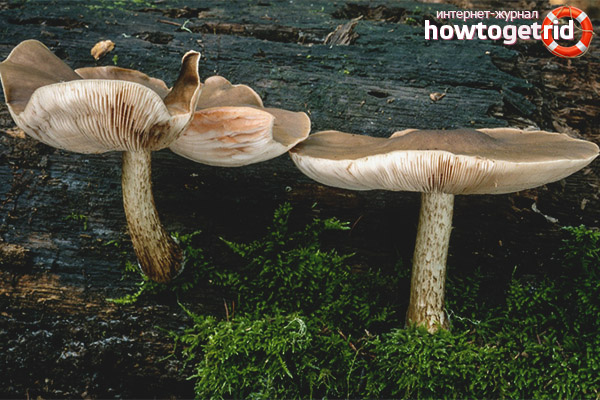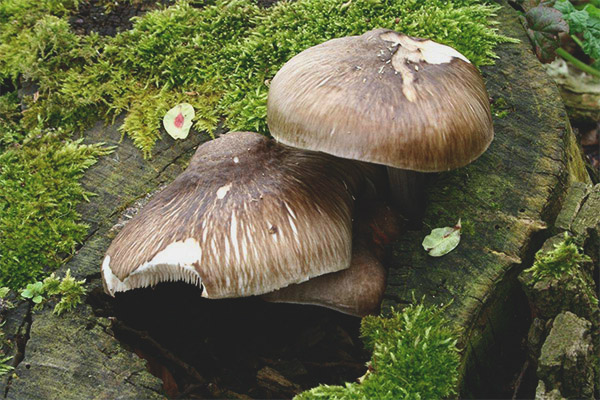The content of the article
A mushroom called deer plumes grows in the forest. It looks ugly, like an ordinary toadstool. But only experienced mushroom pickers will tear it off and put it in a basket, knowing that at home you can enjoy the taste and get some benefit from eating the fungus.
Description
Fungus deer mushroom comes from the family of the plutes, and has other names: reindeer mushroom, dark fibrous plumes, brown plumes. The deer is called not because the fungus is so much adored by the deer (although it is really a pleasure to eat), but because of the color it is just the color of the hair of this northern animal. And also because the hymen ends with small growths that look like deer horns.
This agaric is edible, but in some sources they are convinced that it is not necessary to eat it. At the same time, without naming the reason at all.
The fungus has a changeable appearance, there are several options.
The hat. Very large, the diameter can be quite small - 4 cm, and large - 15 cm, there are larger specimens - 25 cm. And the shape is different - it can be simply convex, in the form of a wide bell. It may be convex, but have a tubercle in the middle. And sometimes prostrate. The skin is smooth, during rain it becomes mucous. Along the surface are fibers. Color varies from grayish-chocolate to dark brown, if the drought is worth - colorless. At the edges it is lighter than in the middle.
Leg. Not very thick, 1.5-2 centimeters in diameter, cylindrical in shape, the thickening goes to the base, it separates easily from the cap. Depending on the place where the grass grows, it can be a bit crooked. The color is light gray, closer to white, the darkish fibers are clearly visible, you can occasionally notice a pattern in the form of a net. The flesh is light white, the color does not change at the break, it is thick, rather hard, but breaks easily. The taste is pleasant enough, even something unusual.
Records. They are located loosely, often, plump, wide, in young mushrooms white-pink, in older ones - brown-pink. Spores oval, color pink, smooth.
Spread
It grows almost throughout Europe and in most of Russia. It belongs to saprophytes, therefore - it grows on decaying or already dead conifers and hardwoods. For example, on a pine or on a birch tree, it can grow on oak. This mushroom can be found not only on the trunks - it gladly settles on the stumps of the rotters, rotten branches, it is quite capable of choosing a place for growth of sawdust, an armful of deadwood, the old bark of some tree. Occurs in forests of any type, grows in urban parks, gardens, there is a clearcut. It germinates directly on the ground, if a rotting stump is located nearby - it forms a mycorrhiza with roots.
Fruits from late May to early September, in July and August - the biggest harvest. Even if there is no rain and the weather is dry, the plumes will grow well and multiply.
Benefit

Plute contains many vitamins of group B, is rich in vitamins C and D, therefore it is fully capable of competing with cereals and liver of beef. In these mushrooms a lot of lecithin, which allows to reduce cholesterol and improve overall health and mood.
A number of antibiotics, medical tinctures and other drugs are obtained from mushrooms. The substances that are part of the sponge help break down fats in the body, and the fiber contained helps fight off unnecessary kilograms and has a good effect on the digestive process.
Also, mushrooms can boast a large amount of different minerals - there are iron, manganese, phosphorus, potassium, copper, iodine.
Culinary use
Only there is one small nuance: it is best to eat juvenile specimens, because in adults (and especially in older ones) the unpleasant sour-rancid taste is not a threat to health, but spoils the whole dish.
Some precautions
There is practically no harm from this fungus.He has a catchy appearance, confusing with toadstools is rather difficult. Poisonous inedible analogs are also not available. Only one danger can lie in wait for a mushroom picker - mushrooms that grow along the roads and near the city accumulate harmful substances. Therefore, having come home, it is better to put the collected prey for half an hour in salted water so that the accumulated toxins are released.
Video: Pluteus deer (Pluteus cervinus)











To send